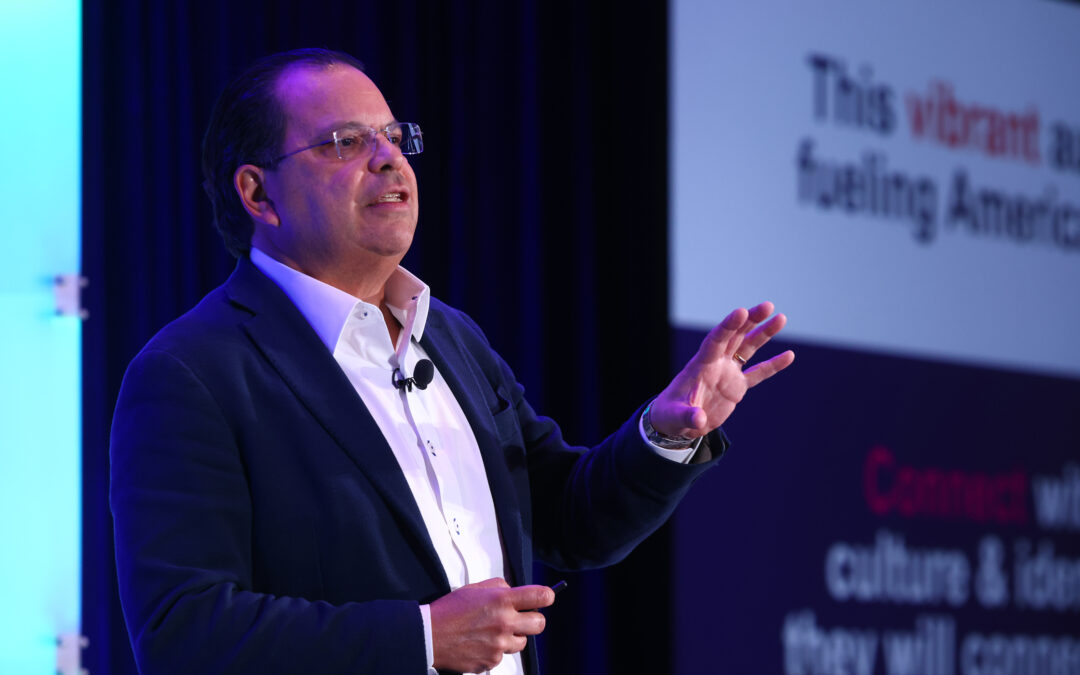The U.S. Hispanic market represents a growing opportunity to increase home and housewares sales, but the best way to do this is to take the time to learn about these consumers, what they’re looking for, and the best ways to engage with them, said Roberto Ruiz, executive vice president, research, insights and analytics for Televisa/Univision, in a keynote address today at The Inspired Home Show 2024.
Owned and operated by the International Housewares Association (IHA), the Show is being held March 17-19 at Chicago’s McCormick Place Complex. This year 1,700 home and housewares companies are exhibiting new products, sharing ideas and building relationships with buyers from more than 140 countries.
“This is about business. It’s about dollars and cents,” said Ruiz in his keynote titled Future-Proofing Your Brand with America’s Growth Engine: The Hispanic Marketing Imperative. “But you can (increase sales) authentically. To win hearts and wallets, it’s all about doing your homework and asking yourself what the insights are related to your brand and the Hispanic consumer that you can leverage to create powerful communications vehicles that generate engagement. How can you make their lives better?”
According to U.S. Census data, Hispanics currently represent 17% of the population over the age of 18, but 26% of the population under age 18. Hispanics are expected to account for 59% of population growth in the U.S. between 2023 and 2033.
What’s more, their spending power is increasing. Ruiz said Hispanic households earning more than $100,000 more than quintupled between 2000 and 2021, while adding that Hispanics are financially resilient and optimistic about their future. Seventy-eight percent of total college enrollment growth in this decade will come from Hispanics, as will 91% of labor growth (2021-2031).
“This vibrant audience is fueling America’s growth,” said Ruiz. “If you connect with their culture and identity, they will connect with you.”
It’s important to recognize that Hispanic culture especially values food and family, represented in the fact that Hispanics generally have larger households (with multiple generations under one roof) and more kids. That’s part of the reason more Hispanics shop at warehouse or club stores than the U.S. average (according to Circana data).
When it comes to shopping, Ruiz said Hispanics prefer bricks and mortar stores, calling them both “leisure shoppers” and “value shoppers.” “They want mainstream brands at lower prices,” he said. In fact, Circana data shows a higher proportion of Hispanics shop at off-price stores than the U.S. average.
In terms of identity, Ruiz said U.S. Hispanics generally have three prongs to their identity: their Hispanic identity, their identity connected to their country of origin and their American identity. Language is an intrinsic part of the Hispanic identity. In fact, Ruiz said that 83% of Hispanics say they appreciate businesses that speak to them in Spanish; 84% feel companies deserve their loyalty if they make sincere efforts to be part of/invest in their community.
That said, Ruiz said companies shouldn’t feel like they need to completely engage with Hispanics in Spanish. His data shows that 60% of Hispanics feel that if an advertiser runs ads in Spanish, they are more likely to visit their website, even if it’s only available in English; 71% feel comfortable shopping and buying on English-only websites.
He does advise home and housewares retailers and brands to include multi-cultural consumers at every stage of the process in planning, product development and marketing. Getting to know the Hispanic community can help drive new product ideas or features from the beginning, such as cookware that is designed to feed a larger family.
When focus groups are held, make sure to have one in Spanish for Hispanic consumers. And consider the unique cultural and identity of Hispanics when developing advertising and marketing. It’s going to be much harder and much more expensive if you try to redo or repackage something you’ve already created for other audiences, he pointed out.
Measurement is also an important tool in determining success. Ruiz recommends adding Hispanic KPIs to executive score cards, and also noted that Neilsen’s ROI of Inclusivity Report found that money spent on Spanish-language television advertising has a return four times higher than its English-language counterparts.
Ruiz also advises companies to be consistent and proportional with their marketing spend throughout the year. Hispanic Heritage Month is a good start, but “one month is not going work (if you really want to connect with Hispanics),” he said.
A video recording of the program will be posted on the Show’s website at TheInspiredHomeShow.com/education/#keynotes. The Inspired Home Show, IHA’s global home + housewares marketplace, is being held March 17-19 at Chicago’s McCormick Place Complex and features exhibitors and buyer attendees from around the globe. For more information about the 2024 Show visit TheInspiredHomeShow.com. To search for new products at the Show visit Connect 365, the Show’s online directory.

